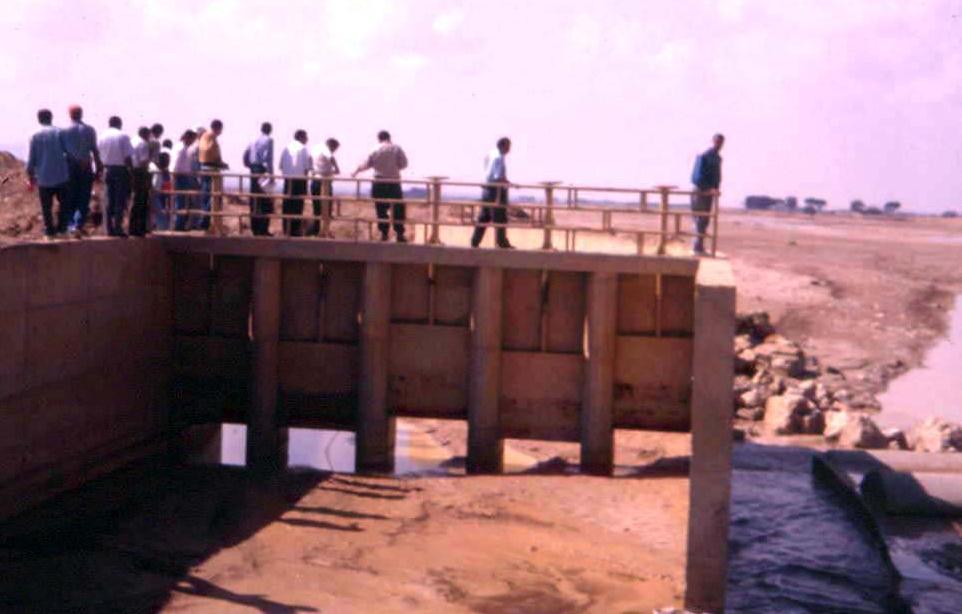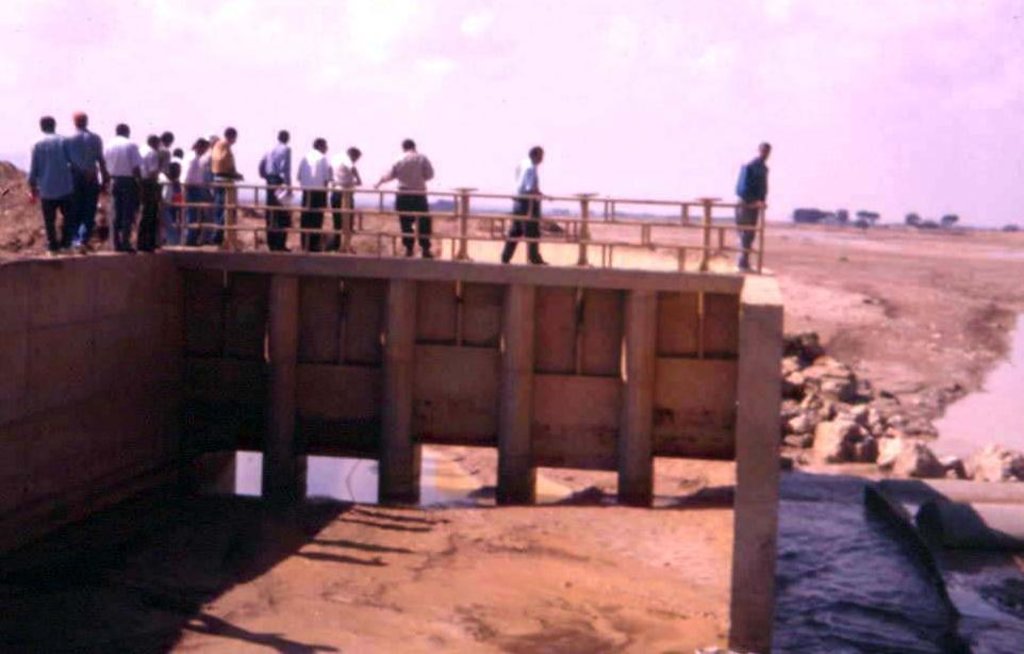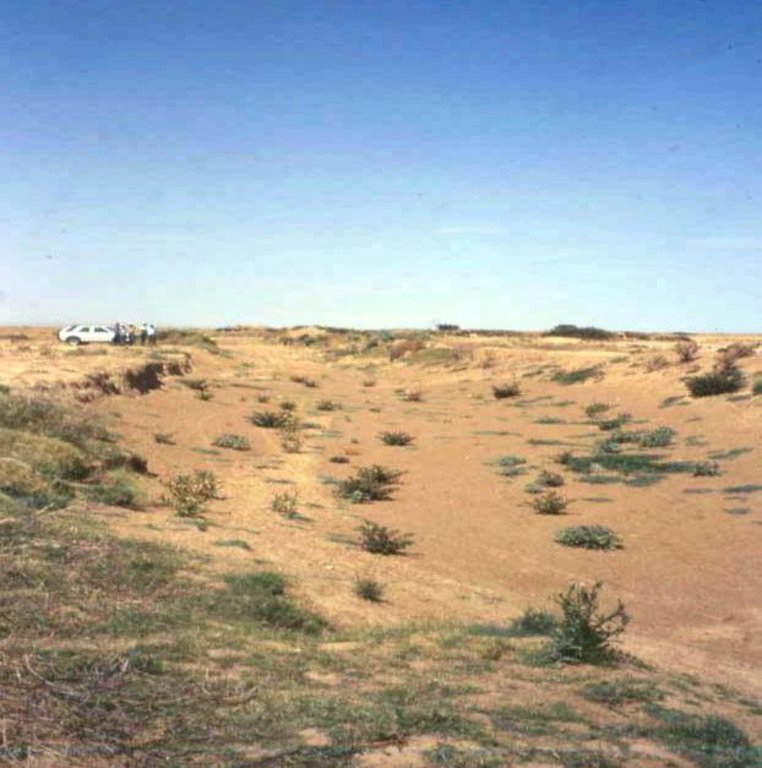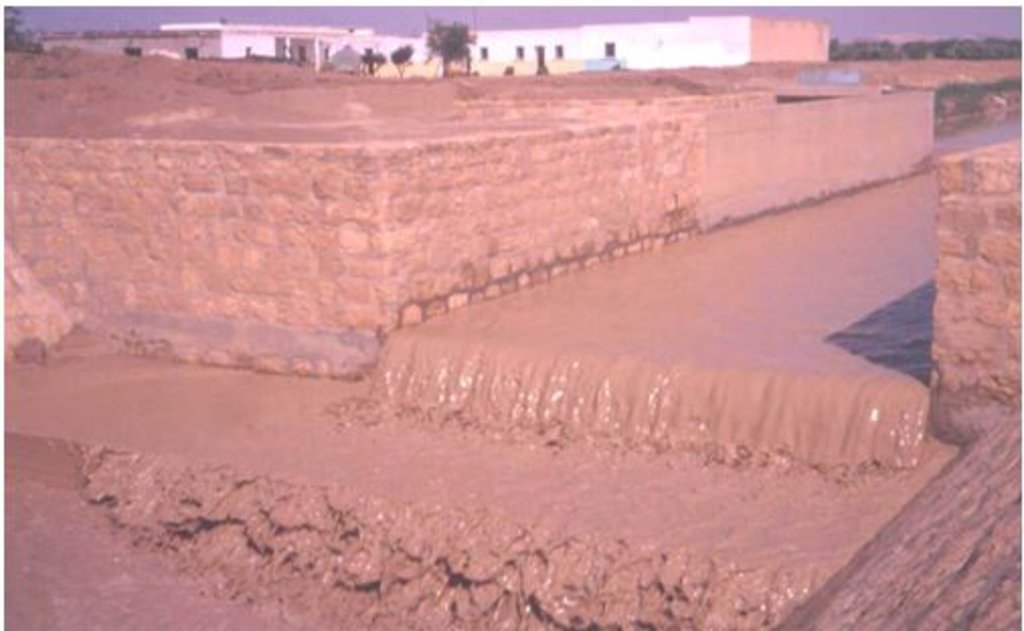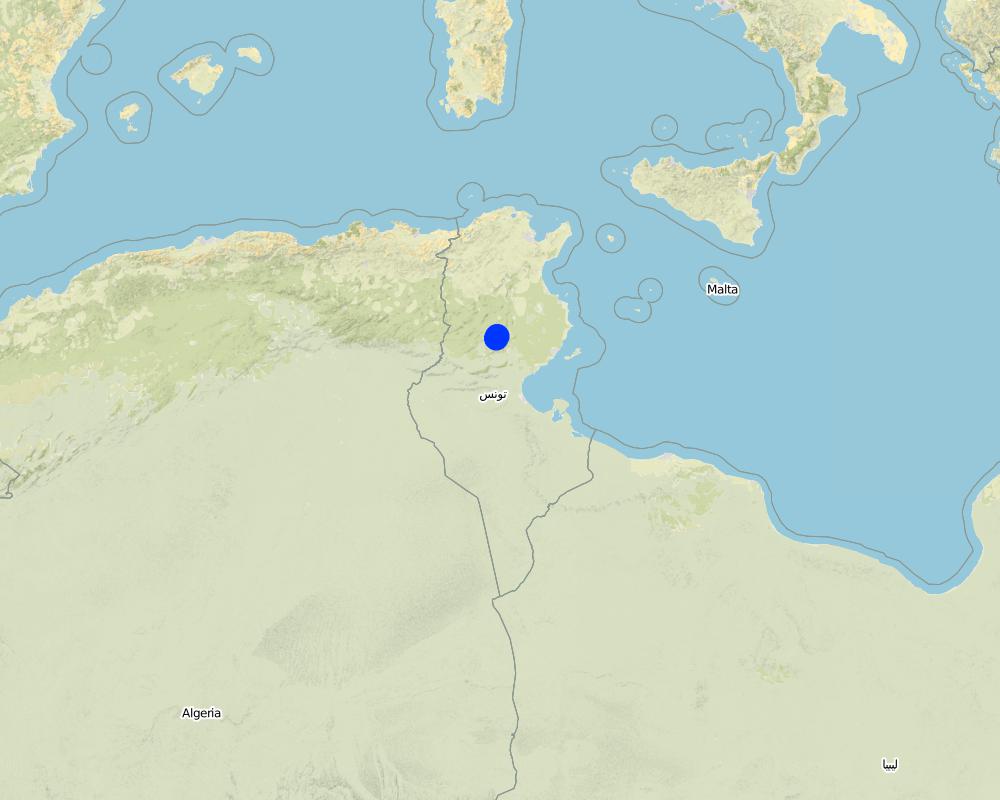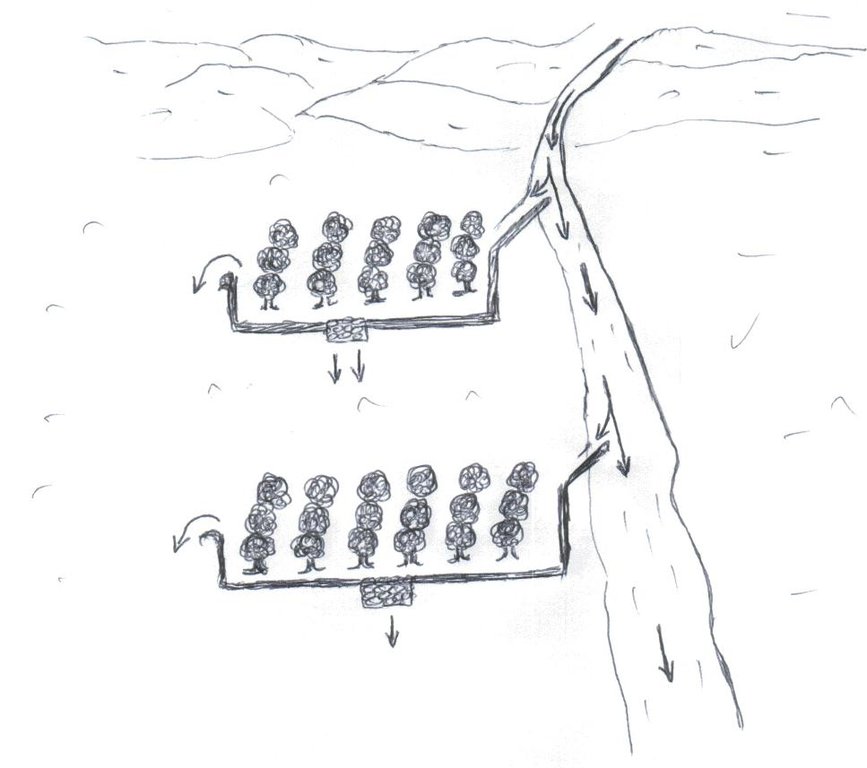Valorisation des eaux de crues à travers la technique des « Mgouds » [Tunisia]
- Creation:
- Update:
- Compiler: Donia Mühlematter
- Editor: –
- Reviewer: Donia Mühlematter
استغلال مياه الفيضانات باعتماد تقنية المقود
technologies_4167 - Tunisia
View sections
Expand all Collapse all1. General information
1.2 Contact details of resource persons and institutions involved in the assessment and documentation of the Technology
SLM specialist:
Name of project which facilitated the documentation/ evaluation of the Technology (if relevant)
Decision Support for Mainstreaming and Scaling out Sustainable Land Management (GEF-FAO / DS-SLM)Name of the institution(s) which facilitated the documentation/ evaluation of the Technology (if relevant)
CDE Centre for Development and Environment (CDE Centre for Development and Environment) - SwitzerlandName of the institution(s) which facilitated the documentation/ evaluation of the Technology (if relevant)
Institut des Régions Arides de Médenine (Institut des Régions Arides de Médenine) - Tunisia1.3 Conditions regarding the use of data documented through WOCAT
The compiler and key resource person(s) accept the conditions regarding the use of data documented through WOCAT:
Ja
1.4 Declaration on sustainability of the described Technology
Is the Technology described here problematic with regard to land degradation, so that it cannot be declared a sustainable land management technology?
Nee
2. Description of the SLM Technology
2.1 Short description of the Technology
Definition of the Technology:
Il s’agit, au moyen de travaux plus ou moins compliqués de détourner tout ou une partie des eaux de ruissellement d’un bassin versant qui ont fini par se rassembler dans un lit d’oued vers des champs d’épandage préalablement préparés et ceci par l’intermédiaire soit de simples saignées (Mgoud) se branchant directement sur le lit soit de véritables réseaux (canaux en terre à ciel ouvert : épandage collectif.
2.2 Detailed description of the Technology
Description:
Le système au bord d’une importante dépression, d’un ravin ou d’un oued prélève de l’eau par l’intermédiaire de petits canaux ou banquettes de diversion. Les tabias édifiées par les exploitants se situent presque toujours en dehors des cours aquifères. Il n’y que les banquettes de diversion relativement facile à faire qui sont souvent construites quelques mètres à l’intérieur de la zone aquifère de l’oued. On prévoit que ces banquettes cassent lors des crues exceptionnelles pour protéger tout le système pour être reconstruites par la suite à peu de frais.
Pour ces ouvrages, il n’y a pas de relation concrète entre l’importance de l’impluvium et la superficie cultivée. En général, la rapport entre impluvium et superficie cultivée est largement supérieur à 20 ce qui entraîne des différences prononcées d’alimentation. Les mgouds sont par conséquent alimentés par de grands bassins versants (généralement supérieur à 100 ha) et il n’y a que les précipitations importantes qui provoquent un ruissellement dans les cours d’eau. Une seule pluie qui réactive l’oued peut remplir la retenue et fournir des réserves d’eau pour toute une période de végétation alors que de faibles précipitations ne produisent pas d’écoulement dans les ravins ou les oueds et les ouvrages restent à secs.
2.3 Photos of the Technology
2.5 Country/ region/ locations where the Technology has been applied and which are covered by this assessment
Country:
Tunisia
Region/ State/ Province:
Sidi Bouzid
Specify the spread of the Technology:
- applied at specific points/ concentrated on a small area
Is/are the technology site(s) located in a permanently protected area?
Nee
Map
×2.6 Date of implementation
If precise year is not known, indicate approximate date:
- more than 50 years ago (traditional)
2.7 Introduction of the Technology
Specify how the Technology was introduced:
- as part of a traditional system (> 50 years)
3. Classification of the SLM Technology
3.1 Main purpose(s) of the Technology
- improve production
- reduce, prevent, restore land degradation
- conserve ecosystem
- reduce risk of disasters
3.2 Current land use type(s) where the Technology is applied
Land use mixed within the same land unit:
Nee

Cropland
- Annual cropping
- Tree and shrub cropping
Annual cropping - Specify crops:
- cereals - barley
Annual cropping system:
Continuous root crop
Tree and shrub cropping - Specify crops:
- olive
Number of growing seasons per year:
- 1
Is intercropping practiced?
Ja
If yes, specify which crops are intercropped:
Céréalicultures et cultures maraichères en intercalaire.
Is crop rotation practiced?
Ja
If yes, specify:
Céréalicultures et cultures maraichères.
3.3 Has land use changed due to the implementation of the Technology?
Has land use changed due to the implementation of the Technology?
- No (Continue with question 3.4)
3.4 Water supply
Water supply for the land on which the Technology is applied:
- rainfed
3.5 SLM group to which the Technology belongs
- improved ground/ vegetation cover
- water harvesting
- ecosystem-based disaster risk reduction
3.6 SLM measures comprising the Technology

agronomic measures
- A1: Vegetation/ soil cover

vegetative measures
- V1: Tree and shrub cover
- V2: Grasses and perennial herbaceous plants

structural measures
- S7: Water harvesting/ supply/ irrigation equipment

management measures
- M3: Layout according to natural and human environment
- M4: Major change in timing of activities
3.7 Main types of land degradation addressed by the Technology

soil erosion by water
- Wt: loss of topsoil/ surface erosion
- Wg: gully erosion/ gullying
- Wm: mass movements/ landslides
- Wo: offsite degradation effects
3.8 Prevention, reduction, or restoration of land degradation
Specify the goal of the Technology with regard to land degradation:
- reduce land degradation
- restore/ rehabilitate severely degraded land
4. Technical specifications, implementation activities, inputs, and costs
4.1 Technical drawing of the Technology
Technical specifications (related to technical drawing):
Il s’agit de prélever une partie des eaux de ruissellement d’un oued ou d’un ravin pour irriguer les par-celles avoisinantes. Ces parcelles sont généralement exploitées en arboriculture derrière des tabias.
Author:
Taamallah Houcine
4.2 General information regarding the calculation of inputs and costs
Specify how costs and inputs were calculated:
- per Technology unit
Specify unit:
Oued ou ravin
other/ national currency (specify):
Dinars Tunisien (DT)
Indicate average wage cost of hired labour per day:
10 DT
4.3 Establishment activities
| Activity | Timing (season) | |
|---|---|---|
| 1. | Dans un oued ou un ravin localisé dans une zone de piedmont ou de plaine à pente douce, procéder (généralement au moyen d’engins mécaniques) à la confection d’ouvrage d’épandage (mgoud) permettant le prélèvement d’une ou de toute les eaux charriées pour irriguer les parcelles avoisinantes. | |
| 2. | Les mgouds charrient les eaux vers des parcelles exploitées en arboricultures et en céréalicultures derrière des tabias qui sont aménagées comme indiquer dans la technologie Tabias. | |
| 3. | Valoriser la tabia par l’installation de cultures arboricoles (3 à 4 rangées d’arbres) et céréalières qui bénéficieront des apports des eaux de ruissellement. |
4.4 Costs and inputs needed for establishment
| Specify input | Unit | Quantity | Costs per Unit | Total costs per input | % of costs borne by land users | |
|---|---|---|---|---|---|---|
| Labour | Main d’oeuvre (10DT/personne x 60 jours) | jour | 60.0 | 10.0 | 600.0 | |
| Fertilizers and biocides | 1.0 | |||||
| Construction material | Pierres sèches (28 DT/m3) | unité | 10.0 | 28.0 | 280.0 | |
| Construction material | Remblais (1 DT/m3) | unité | 800.0 | 1.0 | 800.0 | |
| Total costs for establishment of the Technology | 1680.0 | |||||
| Total costs for establishment of the Technology in USD | 1680.0 | |||||
4.5 Maintenance/ recurrent activities
| Activity | Timing/ frequency | |
|---|---|---|
| 1. | L’entretien des mgouds est une condition primordiale pour une bonne productivité des exploitations. Un mauvais entretien a une influence négative sur la croissance des plantes, les rend vulnérables aux sécheresses. | |
| 2. | L’entretien ne concerne que la réparation des banquettes à l’intérieur des cours d’eau réserver pour la déviation des eaux de crues qui sont conçues pour casser lors des évènements pluvieux exceptionnels. Ces réparations ne sont pas coûteuses et devraient être réalisées au cours de la saison sèche. |
4.6 Costs and inputs needed for maintenance/ recurrent activities (per year)
| Specify input | Unit | Quantity | Costs per Unit | Total costs per input | % of costs borne by land users | |
|---|---|---|---|---|---|---|
| Labour | Main d’oeuvre (10DT/personne x 10 jours) | jour | 10.0 | 10.0 | 100.0 | |
| Construction material | Réparation en cas des dégâts | unité | 200.0 | 1.0 | 200.0 | |
| Total costs for maintenance of the Technology | 300.0 | |||||
| Total costs for maintenance of the Technology in USD | 300.0 | |||||
4.7 Most important factors affecting the costs
Describe the most determinate factors affecting the costs:
Le coût de la main d'oeuvre élévé.
5. Natural and human environment
5.1 Climate
Annual rainfall
- < 250 mm
- 251-500 mm
- 501-750 mm
- 751-1,000 mm
- 1,001-1,500 mm
- 1,501-2,000 mm
- 2,001-3,000 mm
- 3,001-4,000 mm
- > 4,000 mm
Agro-climatic zone
- semi-arid
- arid
5.2 Topography
Slopes on average:
- flat (0-2%)
- gentle (3-5%)
- moderate (6-10%)
- rolling (11-15%)
- hilly (16-30%)
- steep (31-60%)
- very steep (>60%)
Landforms:
- plateau/plains
- ridges
- mountain slopes
- hill slopes
- footslopes
- valley floors
Altitudinal zone:
- 0-100 m a.s.l.
- 101-500 m a.s.l.
- 501-1,000 m a.s.l.
- 1,001-1,500 m a.s.l.
- 1,501-2,000 m a.s.l.
- 2,001-2,500 m a.s.l.
- 2,501-3,000 m a.s.l.
- 3,001-4,000 m a.s.l.
- > 4,000 m a.s.l.
Indicate if the Technology is specifically applied in:
- concave situations
5.3 Soils
Soil depth on average:
- very shallow (0-20 cm)
- shallow (21-50 cm)
- moderately deep (51-80 cm)
- deep (81-120 cm)
- very deep (> 120 cm)
Soil texture (topsoil):
- medium (loamy, silty)
- fine/ heavy (clay)
Soil texture (> 20 cm below surface):
- medium (loamy, silty)
- fine/ heavy (clay)
Topsoil organic matter:
- medium (1-3%)
- low (<1%)
5.4 Water availability and quality
Ground water table:
on surface
Availability of surface water:
good
Water quality (untreated):
poor drinking water (treatment required)
Water quality refers to:
ground water
Is water salinity a problem?
Nee
Is flooding of the area occurring?
Nee
5.5 Biodiversity
Species diversity:
- medium
Habitat diversity:
- medium
5.6 Characteristics of land users applying the Technology
Sedentary or nomadic:
- Sedentary
Market orientation of production system:
- subsistence (self-supply)
Off-farm income:
- > 50% of all income
Relative level of wealth:
- average
Individuals or groups:
- individual/ household
Level of mechanization:
- manual work
Gender:
- men
Age of land users:
- middle-aged
Indicate other relevant characteristics of the land users:
Travail régulier du sol et entretien des tabias en cas cassures.
5.7 Average area of land used by land users applying the Technology
- < 0.5 ha
- 0.5-1 ha
- 1-2 ha
- 2-5 ha
- 5-15 ha
- 15-50 ha
- 50-100 ha
- 100-500 ha
- 500-1,000 ha
- 1,000-10,000 ha
- > 10,000 ha
Is this considered small-, medium- or large-scale (referring to local context)?
- medium-scale
5.8 Land ownership, land use rights, and water use rights
Land ownership:
- individual, titled
Land use rights:
- individual
Water use rights:
- communal (organized)
Are land use rights based on a traditional legal system?
Nee
5.9 Access to services and infrastructure
health:
- poor
- moderate
- good
education:
- poor
- moderate
- good
technical assistance:
- poor
- moderate
- good
employment (e.g. off-farm):
- poor
- moderate
- good
markets:
- poor
- moderate
- good
energy:
- poor
- moderate
- good
roads and transport:
- poor
- moderate
- good
drinking water and sanitation:
- poor
- moderate
- good
financial services:
- poor
- moderate
- good
6. Impacts and concluding statements
6.1 On-site impacts the Technology has shown
Socio-economic impacts
Production
crop production
Comments/ specify:
Amélioration de la productivité des terres marginales.
Socio-cultural impacts
food security/ self-sufficiency
Comments/ specify:
Amélioration de la productivité à l’hectare répondant en partie au besoin de la famille.
Ecological impacts
Water cycle/ runoff
surface runoff
Comments/ specify:
Bonne maîtrise et gestion des eaux de ruissellement.
groundwater table/ aquifer
Comments/ specify:
Contribution à la recharge des nappes souterraines.
Soil
soil loss
Comments/ specify:
Protection et conservation des sols contre l’érosion.
Biodiversity: vegetation, animals
Vegetation cover
Comments/ specify:
Conservation des espèces arboricoles locales.
plant diversity
Comments/ specify:
Conservation de la biodiversité.
6.2 Off-site impacts the Technology has shown
downstream flooding
Comments/ specify:
Protection des sites en aval contre les inondations.
6.3 Exposure and sensitivity of the Technology to gradual climate change and climate-related extremes/ disasters (as perceived by land users)
Gradual climate change
Gradual climate change
| Season | increase or decrease | How does the Technology cope with it? | |
|---|---|---|---|
| annual temperature | increase | moderately | |
| annual rainfall | decrease | moderately |
6.4 Cost-benefit analysis
How do the benefits compare with the establishment costs (from land users’ perspective)?
Short-term returns:
slightly positive
Long-term returns:
very positive
How do the benefits compare with the maintenance/ recurrent costs (from land users' perspective)?
Short-term returns:
positive
Long-term returns:
very positive
6.5 Adoption of the Technology
- > 50%
Of all those who have adopted the Technology, how many did so spontaneously, i.e. without receiving any material incentives/ payments?
- 91-100%
Comments:
Cette technologie est largement répandue dans le centre et le Sud tunisien et l’état procède à la réalisation de ces ouvrages depuis des décennies. Les exploitants sont appelés à préparer et entretenir des tabias permettant de maîtriser ces eaux de crues. Actuellement les agriculteurs ont adopté cette technologie puisque les rendements obtenus à l’hectare sont adéquats et contribuent à l’augmentation de leurs revenus surtout au cours des années pluvieuses.
6.6 Adaptation
Has the Technology been modified recently to adapt to changing conditions?
Nee
6.7 Strengths/ advantages/ opportunities of the Technology
| Strengths/ advantages/ opportunities in the land user’s view |
|---|
| Gestion adéquate des eaux de crue --> entretien régulier des ouvrages en cas de pluies exceptionnelles. |
| Strengths/ advantages/ opportunities in the compiler’s or other key resource person’s view |
|---|
| Bonne productivité à l’hectare --> choisir les bonnes pratiques culturales pour améliorer les caractéristiques du sol après les inondations. |
| Opérations d’entretien peu coûteuses --> multiplier ce type d’ouvrages dans les oueds ou les ravins. |
6.8 Weaknesses/ disadvantages/ risks of the Technology and ways of overcoming them
| Weaknesses/ disadvantages/ risks in the land user’s view | How can they be overcome? |
|---|---|
| Mauvaise distribution des eaux de crues entre les parcelles (celles qui se trouvent en amont reçoivent la majeure partie des eaux de crues). | Multiplier ce système tout le long des ravins ou des oueds. |
7. References and links
7.1 Methods/ sources of information
- field visits, field surveys
- compilation from reports and other existing documentation
7.2 References to available publications
Title, author, year, ISBN:
Khlifa Alaya, Werner Viertmann & Thorsten Waibel. 1993. Les Tabias. Eds. Deutsche Gesellschaft für Technische Zusammenarbeit
Available from where? Costs?
Gratuit.
Title, author, year, ISBN:
Netij Ben Mechlia & Mohamed Ouessar. 2004. Water Harvesting systems in Tunisia. In Oweis Theib, Ahmed Hachem & Adriana Bruggeman (eds). 2004. Indigenous Water harvesting systems in West Asia and North Africa. ICARDA, Aleppo, Syria, vi + 173pp. En.
Available from where? Costs?
Gratuit.
Title, author, year, ISBN:
Ennabli N. 1993. Les aménagements hydrauliques et hydro-agricoles traditionnels en Tunisie. Imprimerie officielle de la république tuni-sienne Tunis - Tunisie. 255pp.
Available from where? Costs?
Gratuit.
7.4 General comments
Technologie de GDT: Valorisation des eaux de crues à travers la technique des « Mgouds », Pays : Tunisie.
Nom du projet /Institution : Institut des Régions Arides - Medenine - Tunisie – Panorama 2010.
Links and modules
Expand all Collapse allLinks
No links
Modules
No modules


